Ziheng Zhou
CLASP: Cross-modal Salient Anchor-based Semantic Propagation for Weakly-supervised Dense Audio-Visual Event Localization
Aug 06, 2025Abstract:The Dense Audio-Visual Event Localization (DAVEL) task aims to temporally localize events in untrimmed videos that occur simultaneously in both the audio and visual modalities. This paper explores DAVEL under a new and more challenging weakly-supervised setting (W-DAVEL task), where only video-level event labels are provided and the temporal boundaries of each event are unknown. We address W-DAVEL by exploiting \textit{cross-modal salient anchors}, which are defined as reliable timestamps that are well predicted under weak supervision and exhibit highly consistent event semantics across audio and visual modalities. Specifically, we propose a \textit{Mutual Event Agreement Evaluation} module, which generates an agreement score by measuring the discrepancy between the predicted audio and visual event classes. Then, the agreement score is utilized in a \textit{Cross-modal Salient Anchor Identification} module, which identifies the audio and visual anchor features through global-video and local temporal window identification mechanisms. The anchor features after multimodal integration are fed into an \textit{Anchor-based Temporal Propagation} module to enhance event semantic encoding in the original temporal audio and visual features, facilitating better temporal localization under weak supervision. We establish benchmarks for W-DAVEL on both the UnAV-100 and ActivityNet1.3 datasets. Extensive experiments demonstrate that our method achieves state-of-the-art performance.
IONext: Unlocking the Next Era of Inertial Odometry
Jul 23, 2025Abstract:Researchers have increasingly adopted Transformer-based models for inertial odometry. While Transformers excel at modeling long-range dependencies, their limited sensitivity to local, fine-grained motion variations and lack of inherent inductive biases often hinder localization accuracy and generalization. Recent studies have shown that incorporating large-kernel convolutions and Transformer-inspired architectural designs into CNN can effectively expand the receptive field, thereby improving global motion perception. Motivated by these insights, we propose a novel CNN-based module called the Dual-wing Adaptive Dynamic Mixer (DADM), which adaptively captures both global motion patterns and local, fine-grained motion features from dynamic inputs. This module dynamically generates selective weights based on the input, enabling efficient multi-scale feature aggregation. To further improve temporal modeling, we introduce the Spatio-Temporal Gating Unit (STGU), which selectively extracts representative and task-relevant motion features in the temporal domain. This unit addresses the limitations of temporal modeling observed in existing CNN approaches. Built upon DADM and STGU, we present a new CNN-based inertial odometry backbone, named Next Era of Inertial Odometry (IONext). Extensive experiments on six public datasets demonstrate that IONext consistently outperforms state-of-the-art (SOTA) Transformer- and CNN-based methods. For instance, on the RNIN dataset, IONext reduces the average ATE by 10% and the average RTE by 12% compared to the representative model iMOT.
PHYBench: Holistic Evaluation of Physical Perception and Reasoning in Large Language Models
Apr 22, 2025



Abstract:We introduce PHYBench, a novel, high-quality benchmark designed for evaluating reasoning capabilities of large language models (LLMs) in physical contexts. PHYBench consists of 500 meticulously curated physics problems based on real-world physical scenarios, designed to assess the ability of models to understand and reason about realistic physical processes. Covering mechanics, electromagnetism, thermodynamics, optics, modern physics, and advanced physics, the benchmark spans difficulty levels from high school exercises to undergraduate problems and Physics Olympiad challenges. Additionally, we propose the Expression Edit Distance (EED) Score, a novel evaluation metric based on the edit distance between mathematical expressions, which effectively captures differences in model reasoning processes and results beyond traditional binary scoring methods. We evaluate various LLMs on PHYBench and compare their performance with human experts. Our results reveal that even state-of-the-art reasoning models significantly lag behind human experts, highlighting their limitations and the need for improvement in complex physical reasoning scenarios. Our benchmark results and dataset are publicly available at https://phybench-official.github.io/phybench-demo/.
Dense Audio-Visual Event Localization under Cross-Modal Consistency and Multi-Temporal Granularity Collaboration
Dec 17, 2024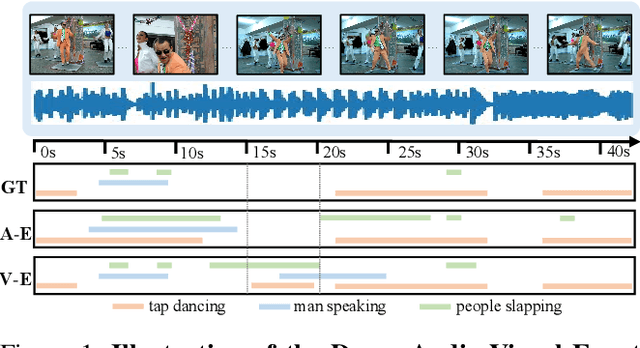
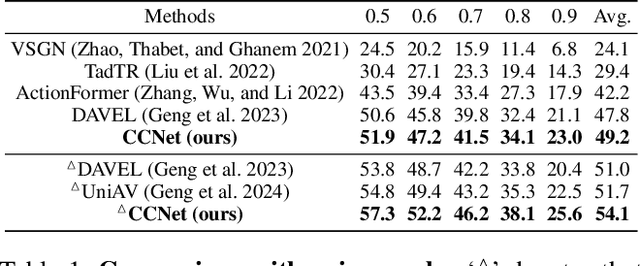
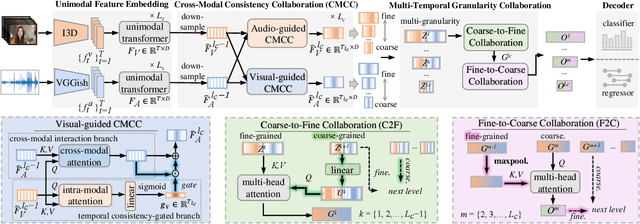
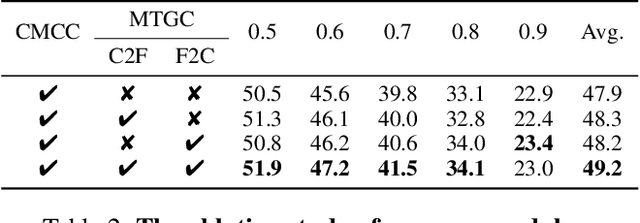
Abstract:In the field of audio-visual learning, most research tasks focus exclusively on short videos. This paper focuses on the more practical Dense Audio-Visual Event Localization (DAVEL) task, advancing audio-visual scene understanding for longer, {untrimmed} videos. This task seeks to identify and temporally pinpoint all events simultaneously occurring in both audio and visual streams. Typically, each video encompasses dense events of multiple classes, which may overlap on the timeline, each exhibiting varied durations. Given these challenges, effectively exploiting the audio-visual relations and the temporal features encoded at various granularities becomes crucial. To address these challenges, we introduce a novel \ul{CC}Net, comprising two core modules: the Cross-Modal Consistency \ul{C}ollaboration (CMCC) and the Multi-Temporal Granularity \ul{C}ollaboration (MTGC). Specifically, the CMCC module contains two branches: a cross-modal interaction branch and a temporal consistency-gated branch. The former branch facilitates the aggregation of consistent event semantics across modalities through the encoding of audio-visual relations, while the latter branch guides one modality's focus to pivotal event-relevant temporal areas as discerned in the other modality. The MTGC module includes a coarse-to-fine collaboration block and a fine-to-coarse collaboration block, providing bidirectional support among coarse- and fine-grained temporal features. Extensive experiments on the UnAV-100 dataset validate our module design, resulting in a new state-of-the-art performance in dense audio-visual event localization. The code is available at \url{https://github.com/zzhhfut/CCNet-AAAI2025}.
Hi-EF: Benchmarking Emotion Forecasting in Human-interaction
Jul 23, 2024



Abstract:Affective Forecasting, a research direction in psychology that predicts individuals future emotions, is often constrained by numerous external factors like social influence and temporal distance. To address this, we transform Affective Forecasting into a Deep Learning problem by designing an Emotion Forecasting paradigm based on two-party interactions. We propose a novel Emotion Forecasting (EF) task grounded in the theory that an individuals emotions are easily influenced by the emotions or other information conveyed during interactions with another person. To tackle this task, we have developed a specialized dataset, Human-interaction-based Emotion Forecasting (Hi-EF), which contains 3069 two-party Multilayered-Contextual Interaction Samples (MCIS) with abundant affective-relevant labels and three modalities. Hi-EF not only demonstrates the feasibility of the EF task but also highlights its potential. Additionally, we propose a methodology that establishes a foundational and referential baseline model for the EF task and extensive experiments are provided. The dataset and code is available at https://github.com/Anonymize-Author/Hi-EF.
All rivers run into the sea: Unified Modality Brain-like Emotional Central Mechanism
Jul 22, 2024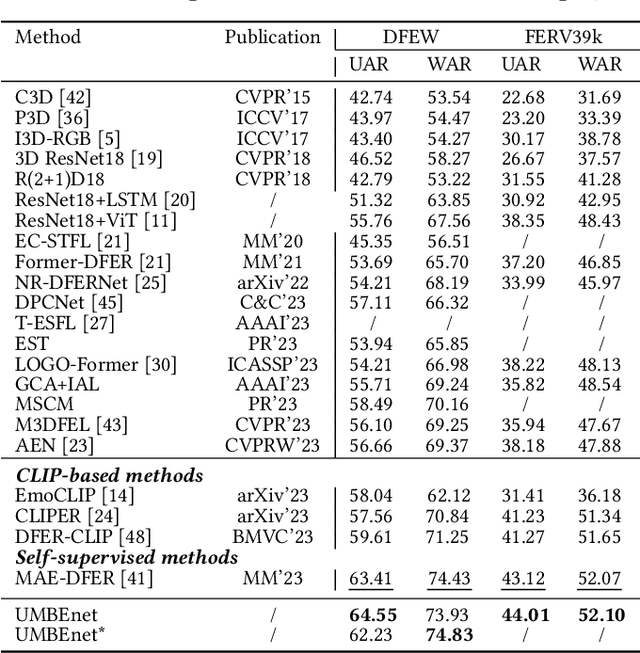


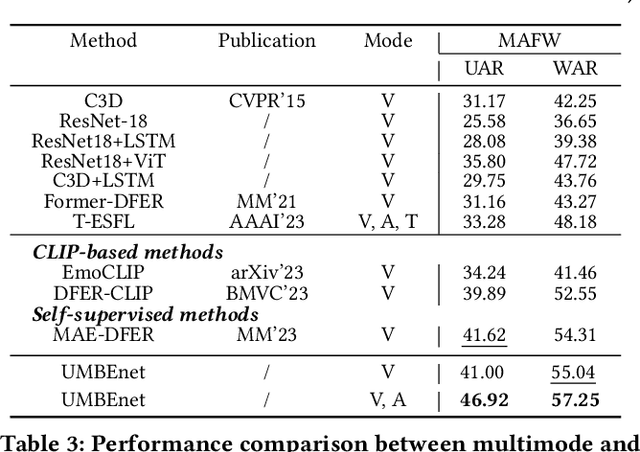
Abstract:In the field of affective computing, fully leveraging information from a variety of sensory modalities is essential for the comprehensive understanding and processing of human emotions. Inspired by the process through which the human brain handles emotions and the theory of cross-modal plasticity, we propose UMBEnet, a brain-like unified modal affective processing network. The primary design of UMBEnet includes a Dual-Stream (DS) structure that fuses inherent prompts with a Prompt Pool and a Sparse Feature Fusion (SFF) module. The design of the Prompt Pool is aimed at integrating information from different modalities, while inherent prompts are intended to enhance the system's predictive guidance capabilities and effectively manage knowledge related to emotion classification. Moreover, considering the sparsity of effective information across different modalities, the SSF module aims to make full use of all available sensory data through the sparse integration of modality fusion prompts and inherent prompts, maintaining high adaptability and sensitivity to complex emotional states. Extensive experiments on the largest benchmark datasets in the Dynamic Facial Expression Recognition (DFER) field, including DFEW, FERV39k, and MAFW, have proven that UMBEnet consistently outperforms the current state-of-the-art methods. Notably, in scenarios of Modality Missingness and multimodal contexts, UMBEnet significantly surpasses the leading current methods, demonstrating outstanding performance and adaptability in tasks that involve complex emotional understanding with rich multimodal information.
Seeking Certainty In Uncertainty: Dual-Stage Unified Framework Solving Uncertainty in Dynamic Facial Expression Recognition
Jun 24, 2024



Abstract:The contemporary state-of-the-art of Dynamic Facial Expression Recognition (DFER) technology facilitates remarkable progress by deriving emotional mappings of facial expressions from video content, underpinned by training on voluminous datasets. Yet, the DFER datasets encompass a substantial volume of noise data. Noise arises from low-quality captures that defy logical labeling, and instances that suffer from mislabeling due to annotation bias, engendering two principal types of uncertainty: the uncertainty regarding data usability and the uncertainty concerning label reliability. Addressing the two types of uncertainty, we have meticulously crafted a two-stage framework aiming at \textbf{S}eeking \textbf{C}ertain data \textbf{I}n extensive \textbf{U}ncertain data (SCIU). This initiative aims to purge the DFER datasets of these uncertainties, thereby ensuring that only clean, verified data is employed in training processes. To mitigate the issue of low-quality samples, we introduce the Coarse-Grained Pruning (CGP) stage, which assesses sample weights and prunes those deemed unusable due to their low weight. For samples with incorrect annotations, the Fine-Grained Correction (FGC) stage evaluates prediction stability to rectify mislabeled data. Moreover, SCIU is conceived as a universally compatible, plug-and-play framework, tailored to integrate seamlessly with prevailing DFER methodologies. Rigorous experiments across prevalent DFER datasets and against numerous benchmark methods substantiates SCIU's capacity to markedly elevate performance metrics.
A$^{3}$lign-DFER: Pioneering Comprehensive Dynamic Affective Alignment for Dynamic Facial Expression Recognition with CLIP
Mar 07, 2024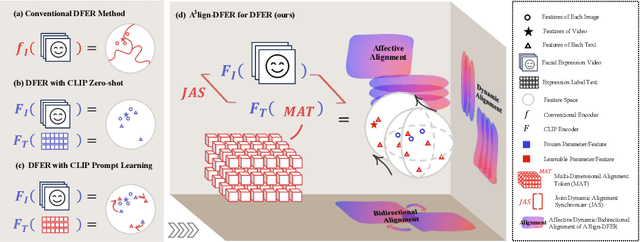
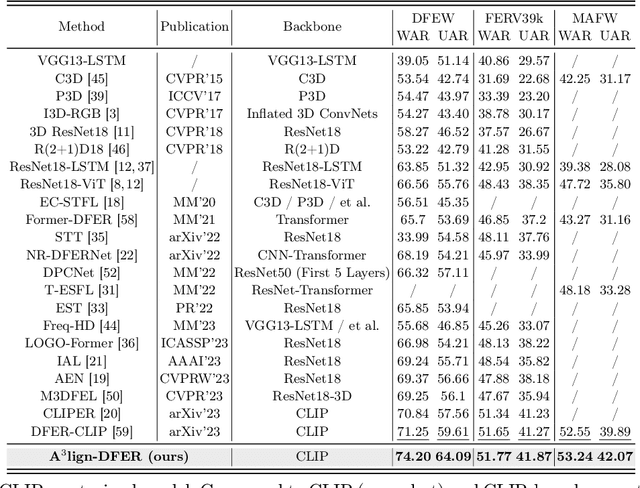
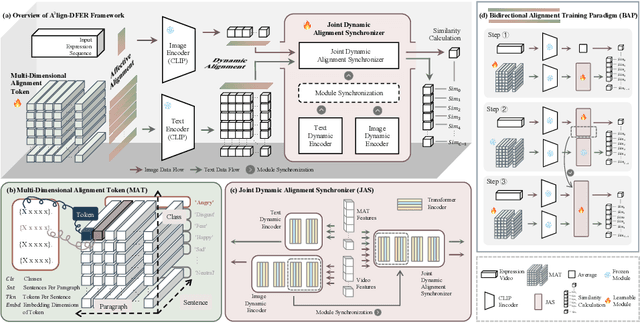

Abstract:The performance of CLIP in dynamic facial expression recognition (DFER) task doesn't yield exceptional results as observed in other CLIP-based classification tasks. While CLIP's primary objective is to achieve alignment between images and text in the feature space, DFER poses challenges due to the abstract nature of text and the dynamic nature of video, making label representation limited and perfect alignment difficult. To address this issue, we have designed A$^{3}$lign-DFER, which introduces a new DFER labeling paradigm to comprehensively achieve alignment, thus enhancing CLIP's suitability for the DFER task. Specifically, our A$^{3}$lign-DFER method is designed with multiple modules that work together to obtain the most suitable expanded-dimensional embeddings for classification and to achieve alignment in three key aspects: affective, dynamic, and bidirectional. We replace the input label text with a learnable Multi-Dimensional Alignment Token (MAT), enabling alignment of text to facial expression video samples in both affective and dynamic dimensions. After CLIP feature extraction, we introduce the Joint Dynamic Alignment Synchronizer (JAS), further facilitating synchronization and alignment in the temporal dimension. Additionally, we implement a Bidirectional Alignment Training Paradigm (BAP) to ensure gradual and steady training of parameters for both modalities. Our insightful and concise A$^{3}$lign-DFER method achieves state-of-the-art results on multiple DFER datasets, including DFEW, FERV39k, and MAFW. Extensive ablation experiments and visualization studies demonstrate the effectiveness of A$^{3}$lign-DFER. The code will be available in the future.
ARNOLD: A Benchmark for Language-Grounded Task Learning With Continuous States in Realistic 3D Scenes
Apr 09, 2023



Abstract:Understanding the continuous states of objects is essential for task learning and planning in the real world. However, most existing task learning benchmarks assume discrete(e.g., binary) object goal states, which poses challenges for the learning of complex tasks and transferring learned policy from simulated environments to the real world. Furthermore, state discretization limits a robot's ability to follow human instructions based on the grounding of actions and states. To tackle these challenges, we present ARNOLD, a benchmark that evaluates language-grounded task learning with continuous states in realistic 3D scenes. ARNOLD is comprised of 8 language-conditioned tasks that involve understanding object states and learning policies for continuous goals. To promote language-instructed learning, we provide expert demonstrations with template-generated language descriptions. We assess task performance by utilizing the latest language-conditioned policy learning models. Our results indicate that current models for language-conditioned manipulations continue to experience significant challenges in novel goal-state generalizations, scene generalizations, and object generalizations. These findings highlight the need to develop new algorithms that address this gap and underscore the potential for further research in this area. See our project page at: https://arnold-benchmark.github.io
MDT-Net: Multi-domain Transfer by Perceptual Supervision for Unpaired Images in OCT Scan
Mar 12, 2022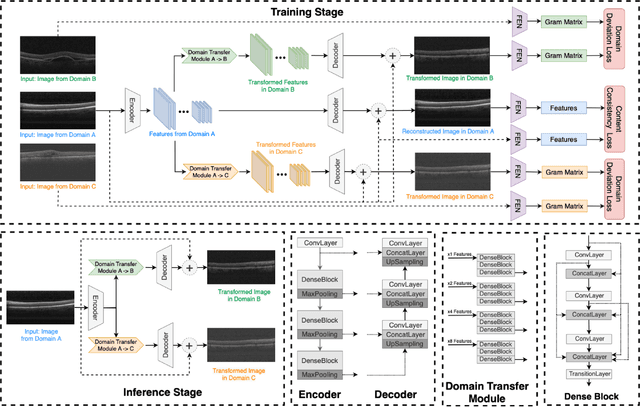

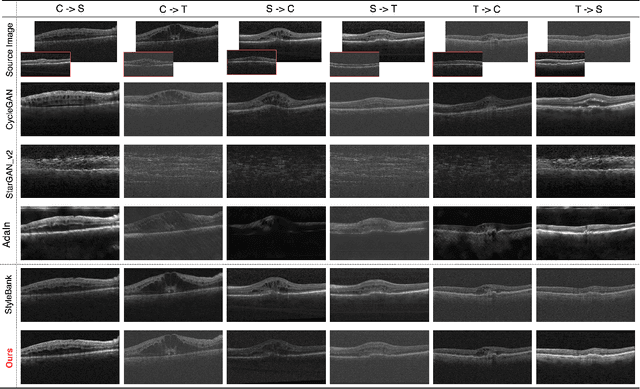
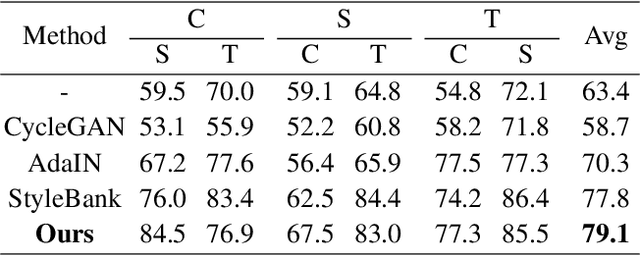
Abstract:Deep learning models tend to underperform in the presence of domain shifts. Domain transfer has recently emerged as a promising approach wherein images exhibiting a domain shift are transformed into other domains for augmentation or adaptation. However, with the absence of paired and annotated images, most domain transfer methods mainly rely on adversarial networks and weak cycle consistency, which could result in incomplete domain transfer or poor adherence to the original image content. In this paper, we introduce MDT-Net to address the limitations above through a multi-domain transfer model based on perceptual supervision. Specifically, our model consists of an encoder-decoder network, which aims to preserve anatomical structures, and multiple domain-specific transfer modules, which guide the domain transition through feature transformation. During the inference, MDT-Net can directly transfer images from the source domain to multiple target domains at one time without any reference image. To demonstrate the performance of MDT-Net, we evaluate it on RETOUCH dataset, comprising OCT scans from three different scanner devices (domains), for multi-domain transfer. We also take the transformed results as additional training images for fluid segmentation in OCT scans in the tasks of domain adaptation and data augmentation. Experimental results show that MDT-Net can outperform other domain transfer models qualitatively and quantitatively. Furthermore, the significant improvement in dice scores over multiple segmentation models also demonstrates the effectiveness and efficiency of our proposed method.
 Add to Chrome
Add to Chrome Add to Firefox
Add to Firefox Add to Edge
Add to Edge